MBALN670: Supply Chain Management Report for Cruise International
VerifiedAdded on 2022/12/26
|10
|2775
|91
Report
AI Summary
This report provides a comprehensive analysis of supply chain management (SCM) principles and their practical application within a service-oriented context, specifically using Cruise International (CII) as a case study. It begins by defining essential SCM concepts, such as the seven rights of fulfillment, SCM flows, and SCM processes, emphasizing their role in optimizing customer satisfaction and operational efficiency. The report then explores the applicability of SCM to service operations like CII, highlighting its potential to enhance customer service, reduce operating costs, and improve financial performance. Furthermore, the report evaluates the benefits of partnering with suppliers, including increased efficiency, price volatility mitigation, and effective outsourcing strategies. It also addresses ethical considerations within the purchasing function, such as corruption, honesty, integrity, and legality, underscoring the importance of ethical practices in SCM. The conclusion emphasizes the crucial role of SCM and ethical considerations in achieving organizational goals and customer satisfaction.

Operations 1
Operations and Quality Managment
Name
Institution
Author’s Note
Operations and Quality Managment
Name
Institution
Author’s Note
Paraphrase This Document
Need a fresh take? Get an instant paraphrase of this document with our AI Paraphraser
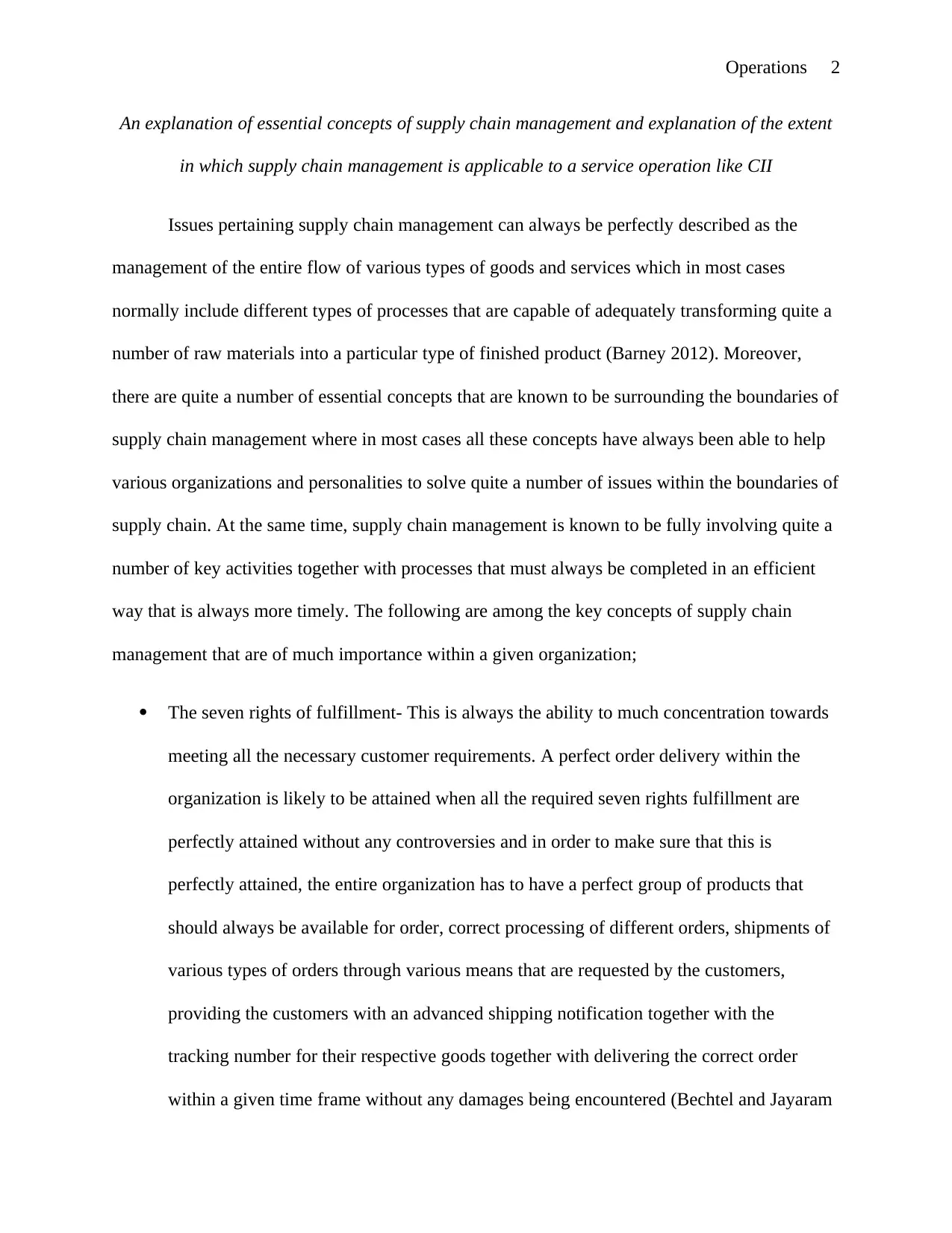
Operations 2
An explanation of essential concepts of supply chain management and explanation of the extent
in which supply chain management is applicable to a service operation like CII
Issues pertaining supply chain management can always be perfectly described as the
management of the entire flow of various types of goods and services which in most cases
normally include different types of processes that are capable of adequately transforming quite a
number of raw materials into a particular type of finished product (Barney 2012). Moreover,
there are quite a number of essential concepts that are known to be surrounding the boundaries of
supply chain management where in most cases all these concepts have always been able to help
various organizations and personalities to solve quite a number of issues within the boundaries of
supply chain. At the same time, supply chain management is known to be fully involving quite a
number of key activities together with processes that must always be completed in an efficient
way that is always more timely. The following are among the key concepts of supply chain
management that are of much importance within a given organization;
The seven rights of fulfillment- This is always the ability to much concentration towards
meeting all the necessary customer requirements. A perfect order delivery within the
organization is likely to be attained when all the required seven rights fulfillment are
perfectly attained without any controversies and in order to make sure that this is
perfectly attained, the entire organization has to have a perfect group of products that
should always be available for order, correct processing of different orders, shipments of
various types of orders through various means that are requested by the customers,
providing the customers with an advanced shipping notification together with the
tracking number for their respective goods together with delivering the correct order
within a given time frame without any damages being encountered (Bechtel and Jayaram
An explanation of essential concepts of supply chain management and explanation of the extent
in which supply chain management is applicable to a service operation like CII
Issues pertaining supply chain management can always be perfectly described as the
management of the entire flow of various types of goods and services which in most cases
normally include different types of processes that are capable of adequately transforming quite a
number of raw materials into a particular type of finished product (Barney 2012). Moreover,
there are quite a number of essential concepts that are known to be surrounding the boundaries of
supply chain management where in most cases all these concepts have always been able to help
various organizations and personalities to solve quite a number of issues within the boundaries of
supply chain. At the same time, supply chain management is known to be fully involving quite a
number of key activities together with processes that must always be completed in an efficient
way that is always more timely. The following are among the key concepts of supply chain
management that are of much importance within a given organization;
The seven rights of fulfillment- This is always the ability to much concentration towards
meeting all the necessary customer requirements. A perfect order delivery within the
organization is likely to be attained when all the required seven rights fulfillment are
perfectly attained without any controversies and in order to make sure that this is
perfectly attained, the entire organization has to have a perfect group of products that
should always be available for order, correct processing of different orders, shipments of
various types of orders through various means that are requested by the customers,
providing the customers with an advanced shipping notification together with the
tracking number for their respective goods together with delivering the correct order
within a given time frame without any damages being encountered (Bechtel and Jayaram
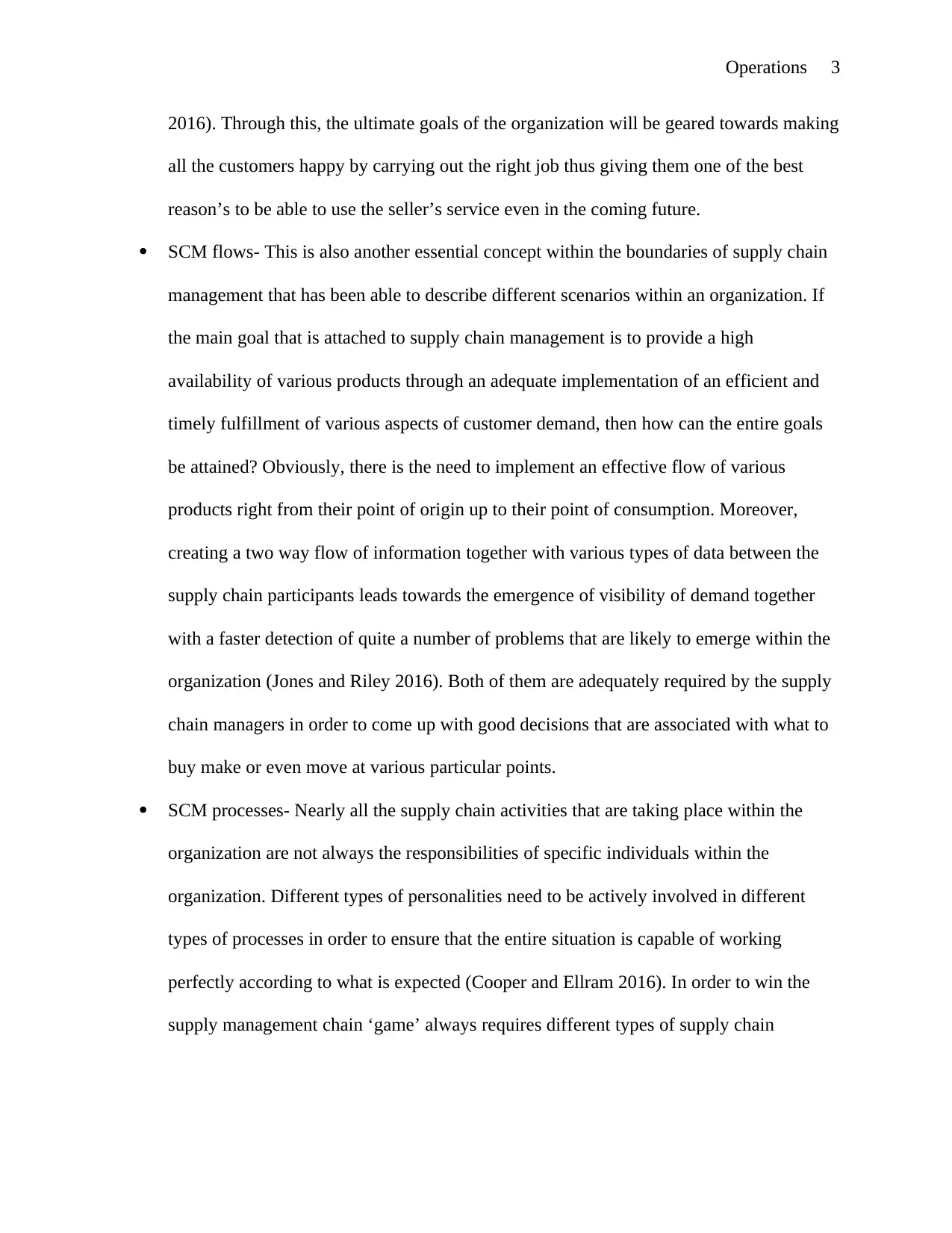
Operations 3
2016). Through this, the ultimate goals of the organization will be geared towards making
all the customers happy by carrying out the right job thus giving them one of the best
reason’s to be able to use the seller’s service even in the coming future.
SCM flows- This is also another essential concept within the boundaries of supply chain
management that has been able to describe different scenarios within an organization. If
the main goal that is attached to supply chain management is to provide a high
availability of various products through an adequate implementation of an efficient and
timely fulfillment of various aspects of customer demand, then how can the entire goals
be attained? Obviously, there is the need to implement an effective flow of various
products right from their point of origin up to their point of consumption. Moreover,
creating a two way flow of information together with various types of data between the
supply chain participants leads towards the emergence of visibility of demand together
with a faster detection of quite a number of problems that are likely to emerge within the
organization (Jones and Riley 2016). Both of them are adequately required by the supply
chain managers in order to come up with good decisions that are associated with what to
buy make or even move at various particular points.
SCM processes- Nearly all the supply chain activities that are taking place within the
organization are not always the responsibilities of specific individuals within the
organization. Different types of personalities need to be actively involved in different
types of processes in order to ensure that the entire situation is capable of working
perfectly according to what is expected (Cooper and Ellram 2016). In order to win the
supply management chain ‘game’ always requires different types of supply chain
2016). Through this, the ultimate goals of the organization will be geared towards making
all the customers happy by carrying out the right job thus giving them one of the best
reason’s to be able to use the seller’s service even in the coming future.
SCM flows- This is also another essential concept within the boundaries of supply chain
management that has been able to describe different scenarios within an organization. If
the main goal that is attached to supply chain management is to provide a high
availability of various products through an adequate implementation of an efficient and
timely fulfillment of various aspects of customer demand, then how can the entire goals
be attained? Obviously, there is the need to implement an effective flow of various
products right from their point of origin up to their point of consumption. Moreover,
creating a two way flow of information together with various types of data between the
supply chain participants leads towards the emergence of visibility of demand together
with a faster detection of quite a number of problems that are likely to emerge within the
organization (Jones and Riley 2016). Both of them are adequately required by the supply
chain managers in order to come up with good decisions that are associated with what to
buy make or even move at various particular points.
SCM processes- Nearly all the supply chain activities that are taking place within the
organization are not always the responsibilities of specific individuals within the
organization. Different types of personalities need to be actively involved in different
types of processes in order to ensure that the entire situation is capable of working
perfectly according to what is expected (Cooper and Ellram 2016). In order to win the
supply management chain ‘game’ always requires different types of supply chain
⊘ This is a preview!⊘
Do you want full access?
Subscribe today to unlock all pages.

Trusted by 1+ million students worldwide
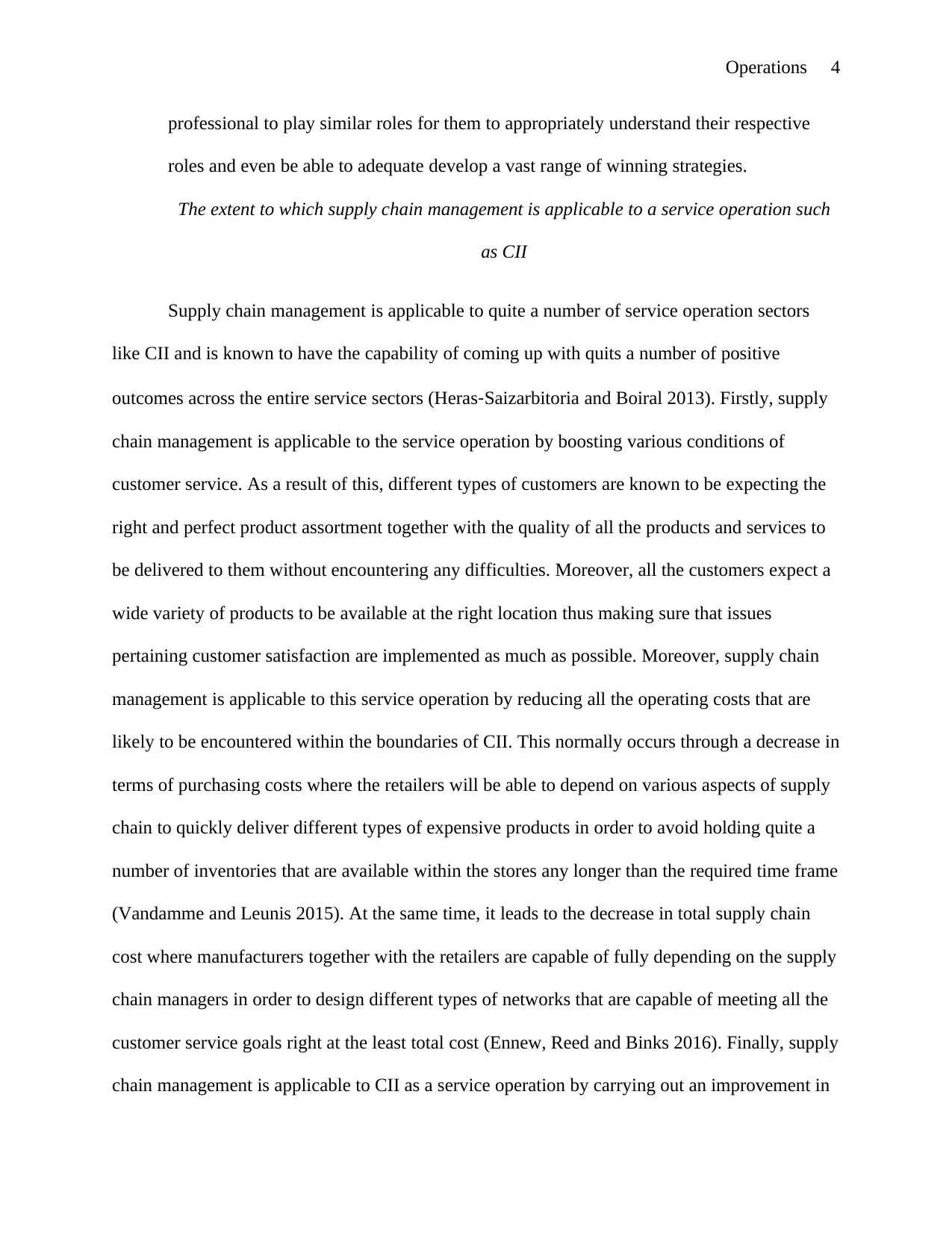
Operations 4
professional to play similar roles for them to appropriately understand their respective
roles and even be able to adequate develop a vast range of winning strategies.
The extent to which supply chain management is applicable to a service operation such
as CII
Supply chain management is applicable to quite a number of service operation sectors
like CII and is known to have the capability of coming up with quits a number of positive
outcomes across the entire service sectors (Heras‐Saizarbitoria and Boiral 2013). Firstly, supply
chain management is applicable to the service operation by boosting various conditions of
customer service. As a result of this, different types of customers are known to be expecting the
right and perfect product assortment together with the quality of all the products and services to
be delivered to them without encountering any difficulties. Moreover, all the customers expect a
wide variety of products to be available at the right location thus making sure that issues
pertaining customer satisfaction are implemented as much as possible. Moreover, supply chain
management is applicable to this service operation by reducing all the operating costs that are
likely to be encountered within the boundaries of CII. This normally occurs through a decrease in
terms of purchasing costs where the retailers will be able to depend on various aspects of supply
chain to quickly deliver different types of expensive products in order to avoid holding quite a
number of inventories that are available within the stores any longer than the required time frame
(Vandamme and Leunis 2015). At the same time, it leads to the decrease in total supply chain
cost where manufacturers together with the retailers are capable of fully depending on the supply
chain managers in order to design different types of networks that are capable of meeting all the
customer service goals right at the least total cost (Ennew, Reed and Binks 2016). Finally, supply
chain management is applicable to CII as a service operation by carrying out an improvement in
professional to play similar roles for them to appropriately understand their respective
roles and even be able to adequate develop a vast range of winning strategies.
The extent to which supply chain management is applicable to a service operation such
as CII
Supply chain management is applicable to quite a number of service operation sectors
like CII and is known to have the capability of coming up with quits a number of positive
outcomes across the entire service sectors (Heras‐Saizarbitoria and Boiral 2013). Firstly, supply
chain management is applicable to the service operation by boosting various conditions of
customer service. As a result of this, different types of customers are known to be expecting the
right and perfect product assortment together with the quality of all the products and services to
be delivered to them without encountering any difficulties. Moreover, all the customers expect a
wide variety of products to be available at the right location thus making sure that issues
pertaining customer satisfaction are implemented as much as possible. Moreover, supply chain
management is applicable to this service operation by reducing all the operating costs that are
likely to be encountered within the boundaries of CII. This normally occurs through a decrease in
terms of purchasing costs where the retailers will be able to depend on various aspects of supply
chain to quickly deliver different types of expensive products in order to avoid holding quite a
number of inventories that are available within the stores any longer than the required time frame
(Vandamme and Leunis 2015). At the same time, it leads to the decrease in total supply chain
cost where manufacturers together with the retailers are capable of fully depending on the supply
chain managers in order to design different types of networks that are capable of meeting all the
customer service goals right at the least total cost (Ennew, Reed and Binks 2016). Finally, supply
chain management is applicable to CII as a service operation by carrying out an improvement in
Paraphrase This Document
Need a fresh take? Get an instant paraphrase of this document with our AI Paraphraser
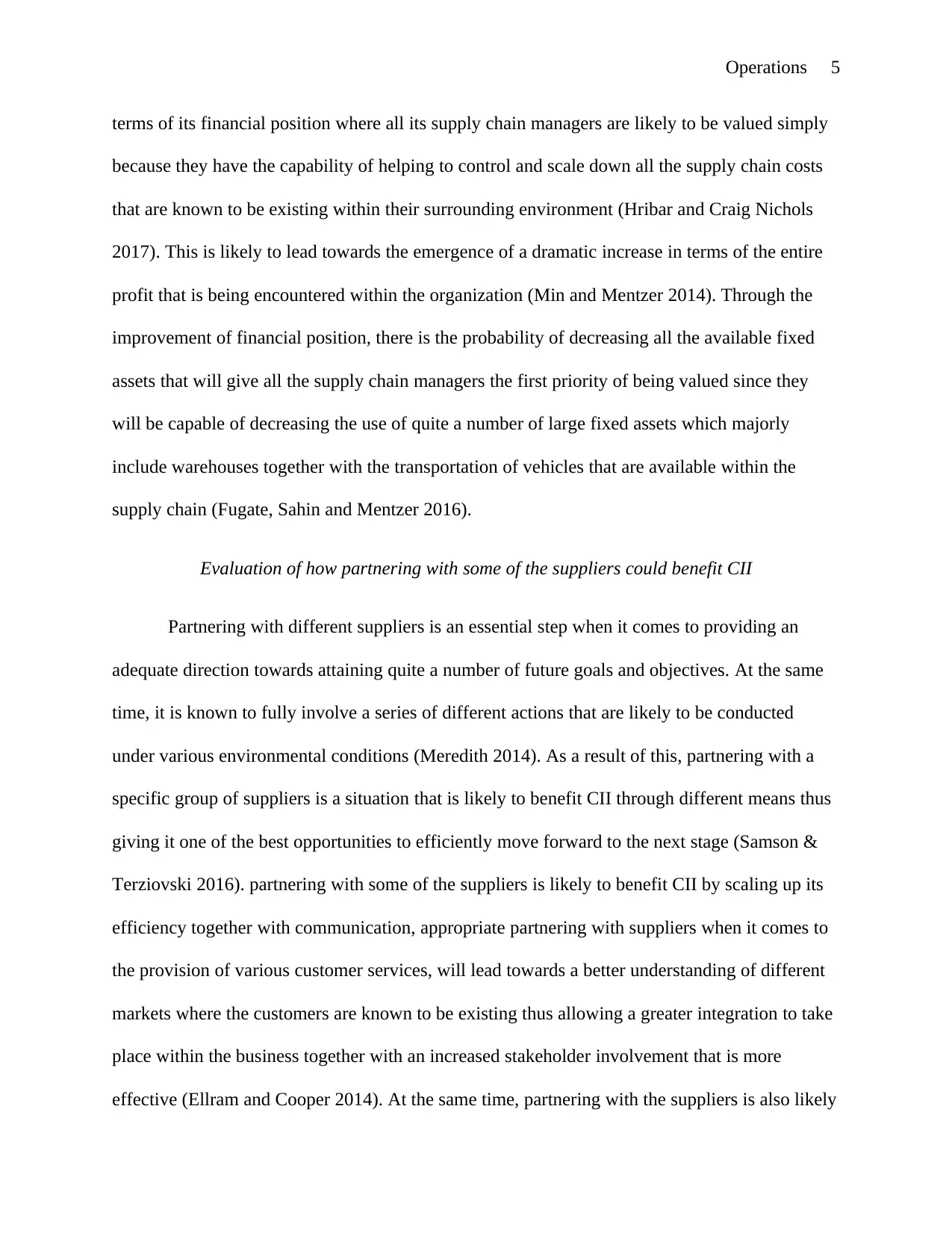
Operations 5
terms of its financial position where all its supply chain managers are likely to be valued simply
because they have the capability of helping to control and scale down all the supply chain costs
that are known to be existing within their surrounding environment (Hribar and Craig Nichols
2017). This is likely to lead towards the emergence of a dramatic increase in terms of the entire
profit that is being encountered within the organization (Min and Mentzer 2014). Through the
improvement of financial position, there is the probability of decreasing all the available fixed
assets that will give all the supply chain managers the first priority of being valued since they
will be capable of decreasing the use of quite a number of large fixed assets which majorly
include warehouses together with the transportation of vehicles that are available within the
supply chain (Fugate, Sahin and Mentzer 2016).
Evaluation of how partnering with some of the suppliers could benefit CII
Partnering with different suppliers is an essential step when it comes to providing an
adequate direction towards attaining quite a number of future goals and objectives. At the same
time, it is known to fully involve a series of different actions that are likely to be conducted
under various environmental conditions (Meredith 2014). As a result of this, partnering with a
specific group of suppliers is a situation that is likely to benefit CII through different means thus
giving it one of the best opportunities to efficiently move forward to the next stage (Samson &
Terziovski 2016). partnering with some of the suppliers is likely to benefit CII by scaling up its
efficiency together with communication, appropriate partnering with suppliers when it comes to
the provision of various customer services, will lead towards a better understanding of different
markets where the customers are known to be existing thus allowing a greater integration to take
place within the business together with an increased stakeholder involvement that is more
effective (Ellram and Cooper 2014). At the same time, partnering with the suppliers is also likely
terms of its financial position where all its supply chain managers are likely to be valued simply
because they have the capability of helping to control and scale down all the supply chain costs
that are known to be existing within their surrounding environment (Hribar and Craig Nichols
2017). This is likely to lead towards the emergence of a dramatic increase in terms of the entire
profit that is being encountered within the organization (Min and Mentzer 2014). Through the
improvement of financial position, there is the probability of decreasing all the available fixed
assets that will give all the supply chain managers the first priority of being valued since they
will be capable of decreasing the use of quite a number of large fixed assets which majorly
include warehouses together with the transportation of vehicles that are available within the
supply chain (Fugate, Sahin and Mentzer 2016).
Evaluation of how partnering with some of the suppliers could benefit CII
Partnering with different suppliers is an essential step when it comes to providing an
adequate direction towards attaining quite a number of future goals and objectives. At the same
time, it is known to fully involve a series of different actions that are likely to be conducted
under various environmental conditions (Meredith 2014). As a result of this, partnering with a
specific group of suppliers is a situation that is likely to benefit CII through different means thus
giving it one of the best opportunities to efficiently move forward to the next stage (Samson &
Terziovski 2016). partnering with some of the suppliers is likely to benefit CII by scaling up its
efficiency together with communication, appropriate partnering with suppliers when it comes to
the provision of various customer services, will lead towards a better understanding of different
markets where the customers are known to be existing thus allowing a greater integration to take
place within the business together with an increased stakeholder involvement that is more
effective (Ellram and Cooper 2014). At the same time, partnering with the suppliers is also likely
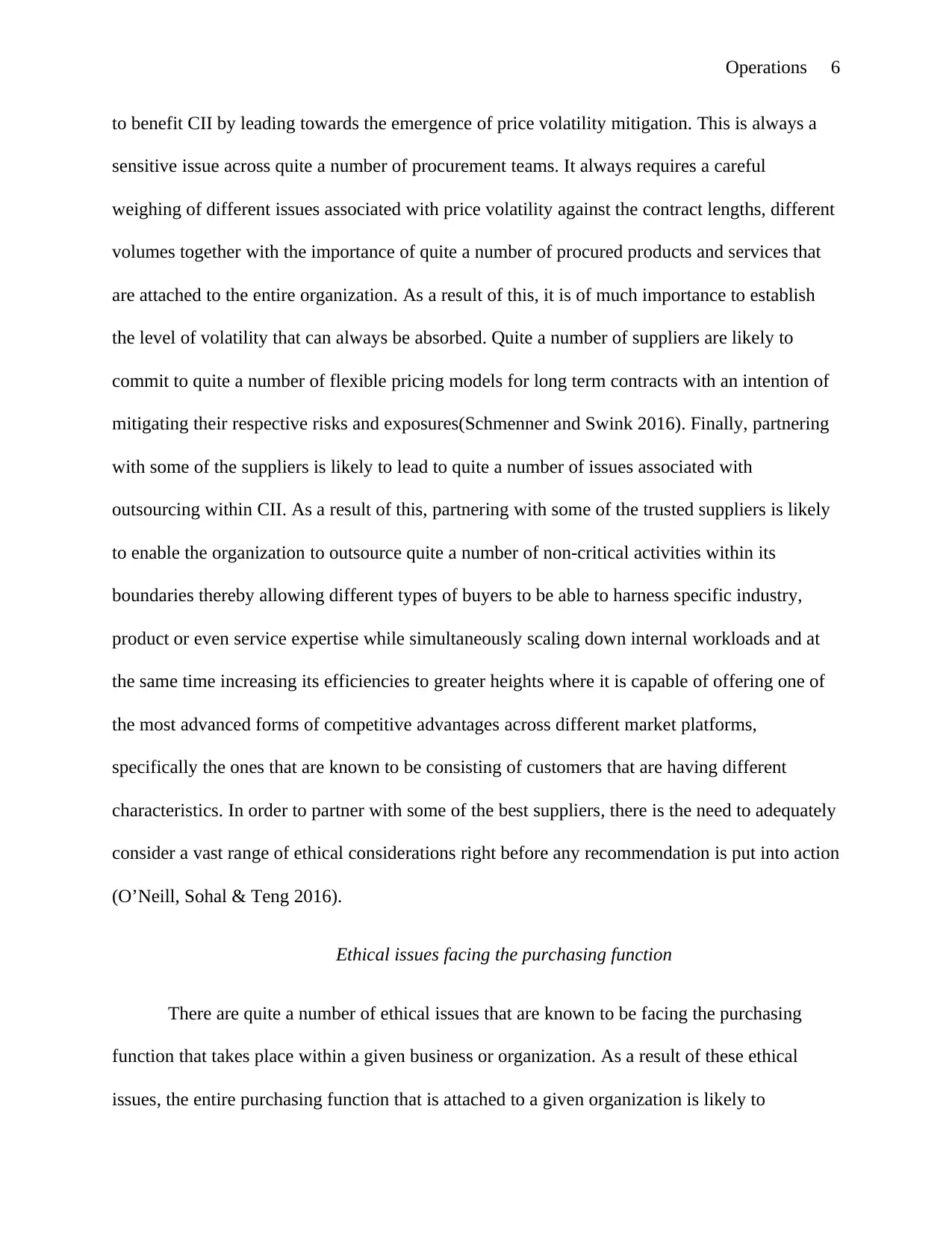
Operations 6
to benefit CII by leading towards the emergence of price volatility mitigation. This is always a
sensitive issue across quite a number of procurement teams. It always requires a careful
weighing of different issues associated with price volatility against the contract lengths, different
volumes together with the importance of quite a number of procured products and services that
are attached to the entire organization. As a result of this, it is of much importance to establish
the level of volatility that can always be absorbed. Quite a number of suppliers are likely to
commit to quite a number of flexible pricing models for long term contracts with an intention of
mitigating their respective risks and exposures(Schmenner and Swink 2016). Finally, partnering
with some of the suppliers is likely to lead to quite a number of issues associated with
outsourcing within CII. As a result of this, partnering with some of the trusted suppliers is likely
to enable the organization to outsource quite a number of non-critical activities within its
boundaries thereby allowing different types of buyers to be able to harness specific industry,
product or even service expertise while simultaneously scaling down internal workloads and at
the same time increasing its efficiencies to greater heights where it is capable of offering one of
the most advanced forms of competitive advantages across different market platforms,
specifically the ones that are known to be consisting of customers that are having different
characteristics. In order to partner with some of the best suppliers, there is the need to adequately
consider a vast range of ethical considerations right before any recommendation is put into action
(O’Neill, Sohal & Teng 2016).
Ethical issues facing the purchasing function
There are quite a number of ethical issues that are known to be facing the purchasing
function that takes place within a given business or organization. As a result of these ethical
issues, the entire purchasing function that is attached to a given organization is likely to
to benefit CII by leading towards the emergence of price volatility mitigation. This is always a
sensitive issue across quite a number of procurement teams. It always requires a careful
weighing of different issues associated with price volatility against the contract lengths, different
volumes together with the importance of quite a number of procured products and services that
are attached to the entire organization. As a result of this, it is of much importance to establish
the level of volatility that can always be absorbed. Quite a number of suppliers are likely to
commit to quite a number of flexible pricing models for long term contracts with an intention of
mitigating their respective risks and exposures(Schmenner and Swink 2016). Finally, partnering
with some of the suppliers is likely to lead to quite a number of issues associated with
outsourcing within CII. As a result of this, partnering with some of the trusted suppliers is likely
to enable the organization to outsource quite a number of non-critical activities within its
boundaries thereby allowing different types of buyers to be able to harness specific industry,
product or even service expertise while simultaneously scaling down internal workloads and at
the same time increasing its efficiencies to greater heights where it is capable of offering one of
the most advanced forms of competitive advantages across different market platforms,
specifically the ones that are known to be consisting of customers that are having different
characteristics. In order to partner with some of the best suppliers, there is the need to adequately
consider a vast range of ethical considerations right before any recommendation is put into action
(O’Neill, Sohal & Teng 2016).
Ethical issues facing the purchasing function
There are quite a number of ethical issues that are known to be facing the purchasing
function that takes place within a given business or organization. As a result of these ethical
issues, the entire purchasing function that is attached to a given organization is likely to
⊘ This is a preview!⊘
Do you want full access?
Subscribe today to unlock all pages.

Trusted by 1+ million students worldwide
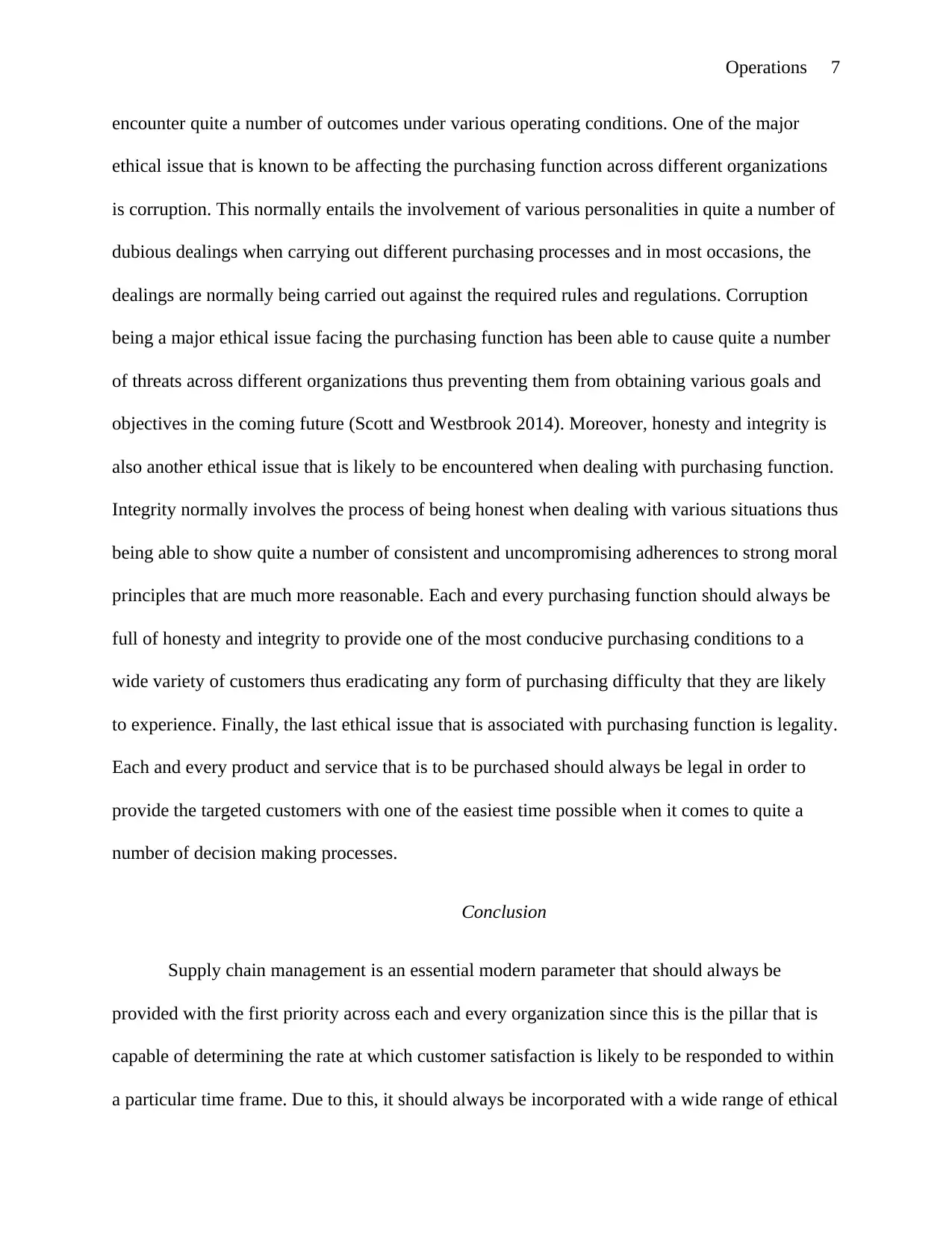
Operations 7
encounter quite a number of outcomes under various operating conditions. One of the major
ethical issue that is known to be affecting the purchasing function across different organizations
is corruption. This normally entails the involvement of various personalities in quite a number of
dubious dealings when carrying out different purchasing processes and in most occasions, the
dealings are normally being carried out against the required rules and regulations. Corruption
being a major ethical issue facing the purchasing function has been able to cause quite a number
of threats across different organizations thus preventing them from obtaining various goals and
objectives in the coming future (Scott and Westbrook 2014). Moreover, honesty and integrity is
also another ethical issue that is likely to be encountered when dealing with purchasing function.
Integrity normally involves the process of being honest when dealing with various situations thus
being able to show quite a number of consistent and uncompromising adherences to strong moral
principles that are much more reasonable. Each and every purchasing function should always be
full of honesty and integrity to provide one of the most conducive purchasing conditions to a
wide variety of customers thus eradicating any form of purchasing difficulty that they are likely
to experience. Finally, the last ethical issue that is associated with purchasing function is legality.
Each and every product and service that is to be purchased should always be legal in order to
provide the targeted customers with one of the easiest time possible when it comes to quite a
number of decision making processes.
Conclusion
Supply chain management is an essential modern parameter that should always be
provided with the first priority across each and every organization since this is the pillar that is
capable of determining the rate at which customer satisfaction is likely to be responded to within
a particular time frame. Due to this, it should always be incorporated with a wide range of ethical
encounter quite a number of outcomes under various operating conditions. One of the major
ethical issue that is known to be affecting the purchasing function across different organizations
is corruption. This normally entails the involvement of various personalities in quite a number of
dubious dealings when carrying out different purchasing processes and in most occasions, the
dealings are normally being carried out against the required rules and regulations. Corruption
being a major ethical issue facing the purchasing function has been able to cause quite a number
of threats across different organizations thus preventing them from obtaining various goals and
objectives in the coming future (Scott and Westbrook 2014). Moreover, honesty and integrity is
also another ethical issue that is likely to be encountered when dealing with purchasing function.
Integrity normally involves the process of being honest when dealing with various situations thus
being able to show quite a number of consistent and uncompromising adherences to strong moral
principles that are much more reasonable. Each and every purchasing function should always be
full of honesty and integrity to provide one of the most conducive purchasing conditions to a
wide variety of customers thus eradicating any form of purchasing difficulty that they are likely
to experience. Finally, the last ethical issue that is associated with purchasing function is legality.
Each and every product and service that is to be purchased should always be legal in order to
provide the targeted customers with one of the easiest time possible when it comes to quite a
number of decision making processes.
Conclusion
Supply chain management is an essential modern parameter that should always be
provided with the first priority across each and every organization since this is the pillar that is
capable of determining the rate at which customer satisfaction is likely to be responded to within
a particular time frame. Due to this, it should always be incorporated with a wide range of ethical
Paraphrase This Document
Need a fresh take? Get an instant paraphrase of this document with our AI Paraphraser
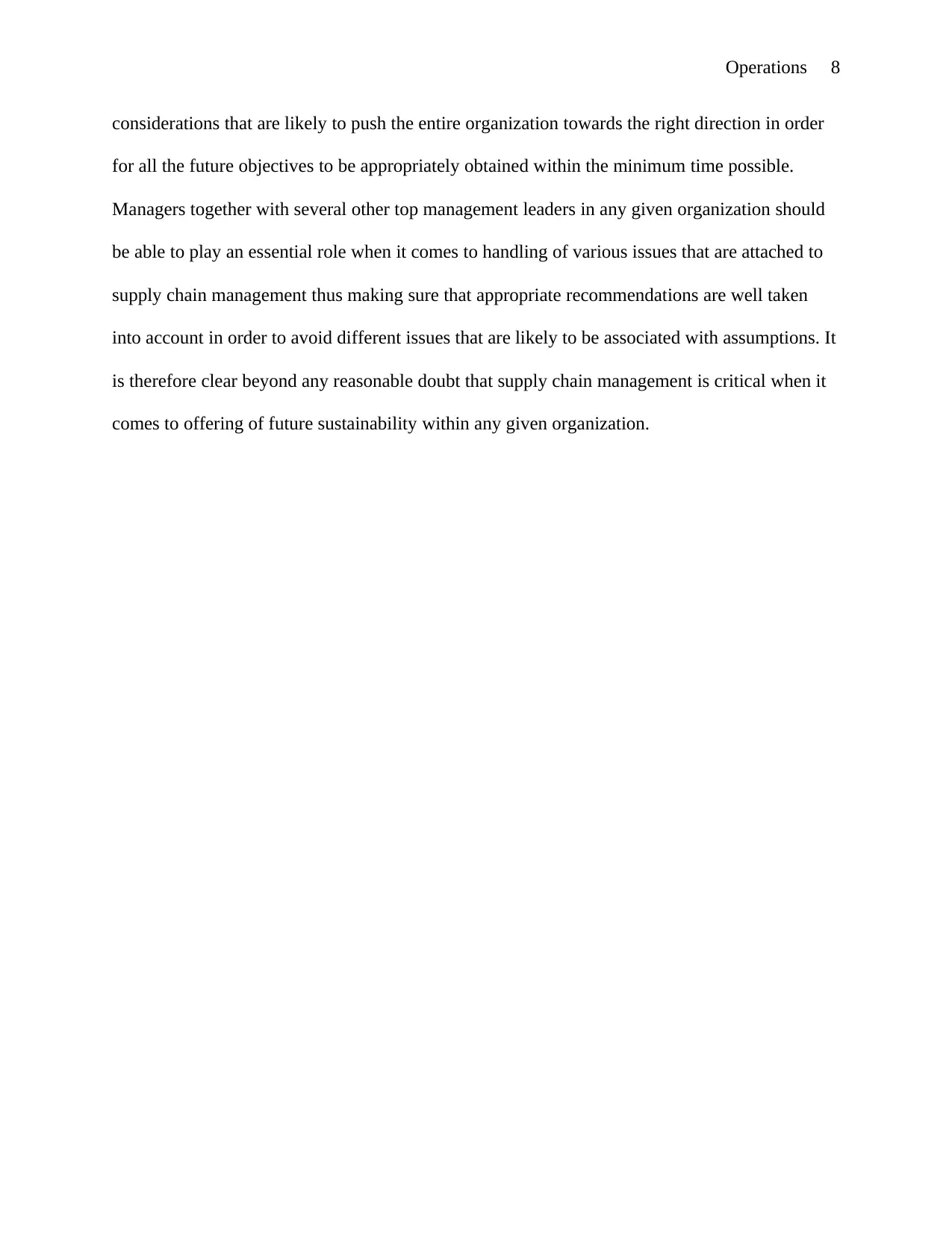
Operations 8
considerations that are likely to push the entire organization towards the right direction in order
for all the future objectives to be appropriately obtained within the minimum time possible.
Managers together with several other top management leaders in any given organization should
be able to play an essential role when it comes to handling of various issues that are attached to
supply chain management thus making sure that appropriate recommendations are well taken
into account in order to avoid different issues that are likely to be associated with assumptions. It
is therefore clear beyond any reasonable doubt that supply chain management is critical when it
comes to offering of future sustainability within any given organization.
considerations that are likely to push the entire organization towards the right direction in order
for all the future objectives to be appropriately obtained within the minimum time possible.
Managers together with several other top management leaders in any given organization should
be able to play an essential role when it comes to handling of various issues that are attached to
supply chain management thus making sure that appropriate recommendations are well taken
into account in order to avoid different issues that are likely to be associated with assumptions. It
is therefore clear beyond any reasonable doubt that supply chain management is critical when it
comes to offering of future sustainability within any given organization.
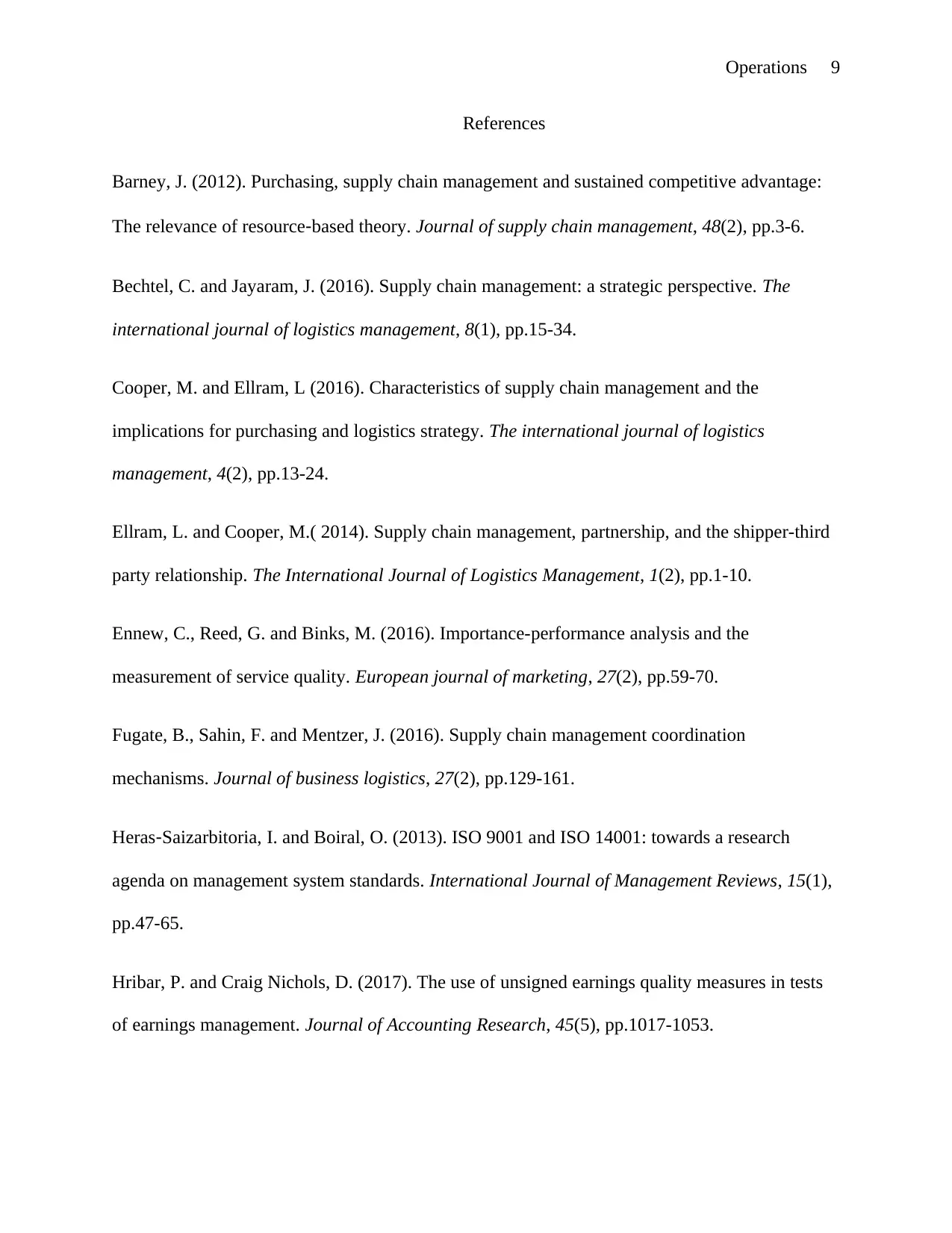
Operations 9
References
Barney, J. (2012). Purchasing, supply chain management and sustained competitive advantage:
The relevance of resource‐based theory. Journal of supply chain management, 48(2), pp.3-6.
Bechtel, C. and Jayaram, J. (2016). Supply chain management: a strategic perspective. The
international journal of logistics management, 8(1), pp.15-34.
Cooper, M. and Ellram, L (2016). Characteristics of supply chain management and the
implications for purchasing and logistics strategy. The international journal of logistics
management, 4(2), pp.13-24.
Ellram, L. and Cooper, M.( 2014). Supply chain management, partnership, and the shipper-third
party relationship. The International Journal of Logistics Management, 1(2), pp.1-10.
Ennew, C., Reed, G. and Binks, M. (2016). Importance-performance analysis and the
measurement of service quality. European journal of marketing, 27(2), pp.59-70.
Fugate, B., Sahin, F. and Mentzer, J. (2016). Supply chain management coordination
mechanisms. Journal of business logistics, 27(2), pp.129-161.
Heras‐Saizarbitoria, I. and Boiral, O. (2013). ISO 9001 and ISO 14001: towards a research
agenda on management system standards. International Journal of Management Reviews, 15(1),
pp.47-65.
Hribar, P. and Craig Nichols, D. (2017). The use of unsigned earnings quality measures in tests
of earnings management. Journal of Accounting Research, 45(5), pp.1017-1053.
References
Barney, J. (2012). Purchasing, supply chain management and sustained competitive advantage:
The relevance of resource‐based theory. Journal of supply chain management, 48(2), pp.3-6.
Bechtel, C. and Jayaram, J. (2016). Supply chain management: a strategic perspective. The
international journal of logistics management, 8(1), pp.15-34.
Cooper, M. and Ellram, L (2016). Characteristics of supply chain management and the
implications for purchasing and logistics strategy. The international journal of logistics
management, 4(2), pp.13-24.
Ellram, L. and Cooper, M.( 2014). Supply chain management, partnership, and the shipper-third
party relationship. The International Journal of Logistics Management, 1(2), pp.1-10.
Ennew, C., Reed, G. and Binks, M. (2016). Importance-performance analysis and the
measurement of service quality. European journal of marketing, 27(2), pp.59-70.
Fugate, B., Sahin, F. and Mentzer, J. (2016). Supply chain management coordination
mechanisms. Journal of business logistics, 27(2), pp.129-161.
Heras‐Saizarbitoria, I. and Boiral, O. (2013). ISO 9001 and ISO 14001: towards a research
agenda on management system standards. International Journal of Management Reviews, 15(1),
pp.47-65.
Hribar, P. and Craig Nichols, D. (2017). The use of unsigned earnings quality measures in tests
of earnings management. Journal of Accounting Research, 45(5), pp.1017-1053.
⊘ This is a preview!⊘
Do you want full access?
Subscribe today to unlock all pages.

Trusted by 1+ million students worldwide
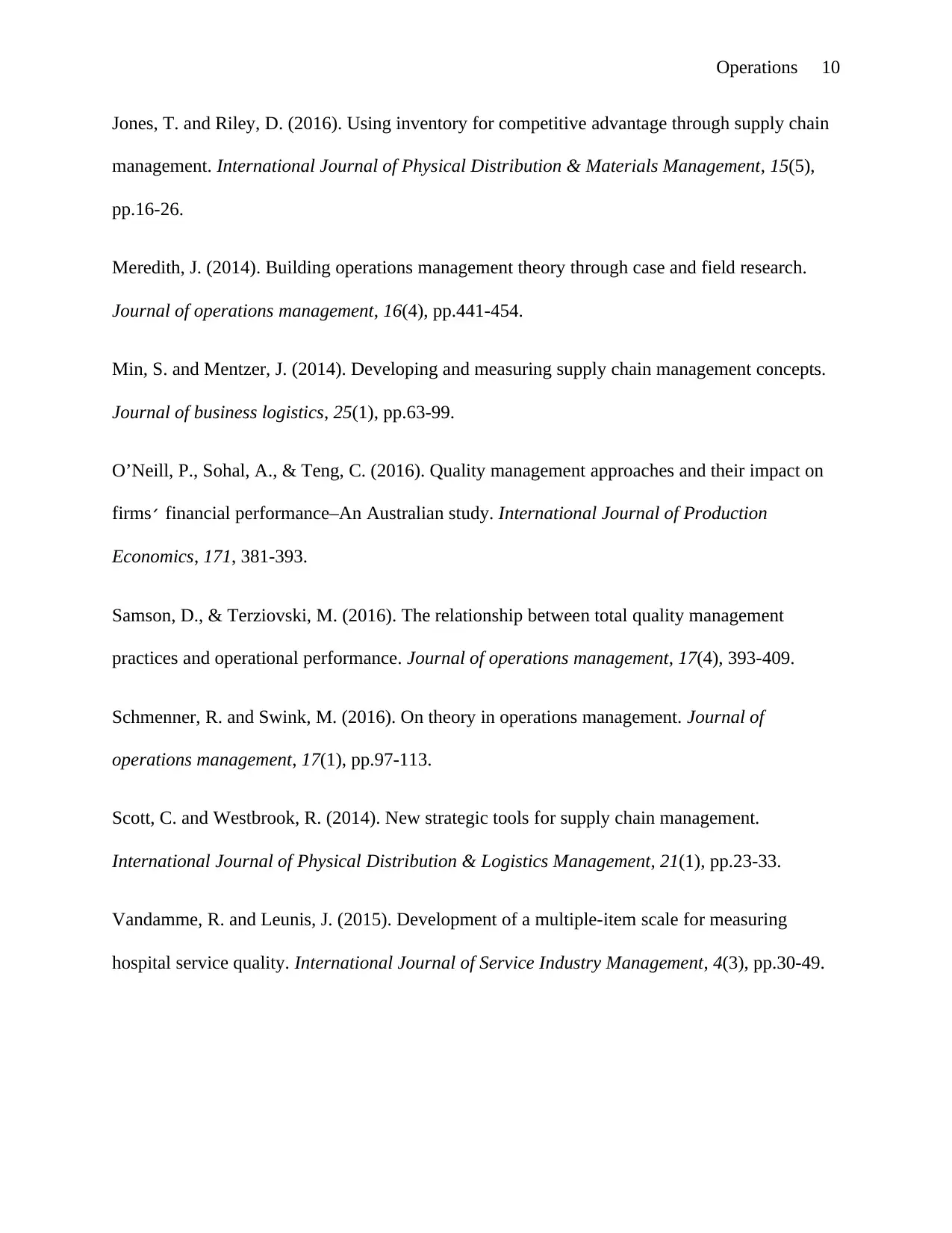
Operations 10
Jones, T. and Riley, D. (2016). Using inventory for competitive advantage through supply chain
management. International Journal of Physical Distribution & Materials Management, 15(5),
pp.16-26.
Meredith, J. (2014). Building operations management theory through case and field research.
Journal of operations management, 16(4), pp.441-454.
Min, S. and Mentzer, J. (2014). Developing and measuring supply chain management concepts.
Journal of business logistics, 25(1), pp.63-99.
O’Neill, P., Sohal, A., & Teng, C. (2016). Quality management approaches and their impact on
firms׳ financial performance–An Australian study. International Journal of Production
Economics, 171, 381-393.
Samson, D., & Terziovski, M. (2016). The relationship between total quality management
practices and operational performance. Journal of operations management, 17(4), 393-409.
Schmenner, R. and Swink, M. (2016). On theory in operations management. Journal of
operations management, 17(1), pp.97-113.
Scott, C. and Westbrook, R. (2014). New strategic tools for supply chain management.
International Journal of Physical Distribution & Logistics Management, 21(1), pp.23-33.
Vandamme, R. and Leunis, J. (2015). Development of a multiple-item scale for measuring
hospital service quality. International Journal of Service Industry Management, 4(3), pp.30-49.
Jones, T. and Riley, D. (2016). Using inventory for competitive advantage through supply chain
management. International Journal of Physical Distribution & Materials Management, 15(5),
pp.16-26.
Meredith, J. (2014). Building operations management theory through case and field research.
Journal of operations management, 16(4), pp.441-454.
Min, S. and Mentzer, J. (2014). Developing and measuring supply chain management concepts.
Journal of business logistics, 25(1), pp.63-99.
O’Neill, P., Sohal, A., & Teng, C. (2016). Quality management approaches and their impact on
firms׳ financial performance–An Australian study. International Journal of Production
Economics, 171, 381-393.
Samson, D., & Terziovski, M. (2016). The relationship between total quality management
practices and operational performance. Journal of operations management, 17(4), 393-409.
Schmenner, R. and Swink, M. (2016). On theory in operations management. Journal of
operations management, 17(1), pp.97-113.
Scott, C. and Westbrook, R. (2014). New strategic tools for supply chain management.
International Journal of Physical Distribution & Logistics Management, 21(1), pp.23-33.
Vandamme, R. and Leunis, J. (2015). Development of a multiple-item scale for measuring
hospital service quality. International Journal of Service Industry Management, 4(3), pp.30-49.
1 out of 10
Related Documents
Your All-in-One AI-Powered Toolkit for Academic Success.
+13062052269
info@desklib.com
Available 24*7 on WhatsApp / Email
![[object Object]](/_next/static/media/star-bottom.7253800d.svg)
Unlock your academic potential
Copyright © 2020–2025 A2Z Services. All Rights Reserved. Developed and managed by ZUCOL.





